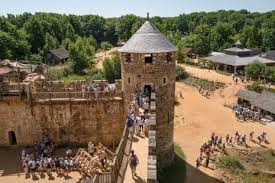‘It’s back to the future’: the 13th-century castle built by hand in France

Jon Henley
Paris: It was the summer of 1999 and, in a disused quarry in a forest in deepest Burgundy, a dozen or so incongruously attired figures were toiling away, hewing limestone blocks, chiselling oaken beams and hammering 6in nails.
The rough outline of what they were building was discernible, just: a perimeter wall a substantial 200 metres long and three metres thick; round towers, two large and two small, to mark the four corners; another pair flanking the main gateway.
Outside the clearing it was almost the 21st century. Inside, it was 1230 and, using only medieval tools and techniques and materials sourced locally or made on site, work had just begun on the castle of Guilbert Courtenay, a fictitious nobleman of relatively modest means.
Back then, the walls were half a metre high and no one had the faintest idea when – or, more to the point, whether – Chateau de Guédelon would ever be finished. No one, after all, had thought to build an early 13th-century castle by hand for about 750 years.
Just over a quarter of a century later, it still is not quite finished. But in the summer of 2025 it is, recognisably and rather splendidly, an early 13th-century French castle, complete with ramparts, turrets, vaulted great hall, chambers, chapel, kitchens and, a little way off in the woods, a working flour mill.
It is also a living archaeological, architectural, cultural, historical, human and even scientific laboratory, praised and prized by everyone from medievalists and heritage restoration experts to professionals in the sustainable construction industry.
“I’m not really sure what I thought would come of it. Back then, it sometimes felt like just … having fun with friends,” said Maryline Martin, Guédelon’s project manager since the start. “It’s been the most amazing adventure. And it’s worked in a way I never dreamed of.”
Returning to Guédelon 25-plus years on provides something of a shock. What was once a bare, muddy expanse of rock-strewn ground dotted with the occasional artisan in a home-spun hemp tunic or a leather apron is now an actual medieval castle. There are also car parks, restaurants, shops, a smart eco-friendly office – and 310,000 visitors a year.
If regional, EU and corporate money funded the hard early years, today the €7.5m raised annually from ticket, food and souvenir sales – including baskets, scarves and bookmarks, all made in Guédelon – pay the investment, running costs and 160 salaries of one of Burgundy’s biggest attractions.
What it is most absolutely not, though, is a medieval theme park.
“This is play, but serious play,” said Martin, unchanged bar her shock of grey hair. Along with Michel Guyot, who had already spent decades restoring a ruined local chateau, she was one of the founding figures of Guédelon, inspired by the madcap idea of building one entirely from scratch. Guyot has since retired from the project.
“It’s about building to understand, inventing the future by rediscovering the past,” Martin said. “It’s actually thoroughly modern, in keeping with an era that values ecology and nature. We’re like a bird building its nest: we take only what we need, from nearby. It’s almost political.”
Guédelon has quarriers, stone cutters, masons, joiners, blacksmiths, tilers, painters, carpenters, ropemakers, wheelwrights, carters and basketmakers – 60-odd artisans in all – building cob and rubblework walls, firing tiles, blending dyes and pigments, braiding rope and forging and beating nails, hinges and decorative ironwork.
The sole concessions to modernity are safety boots for everyone, glasses for those cutting stone, and ropes and carabiner clips for people working on the castle’s medieval-style timber scaffolding (which itself must be health and safety approved).
“It sounds trite, but it’s ‘back to the future’,” said Emmanuel de Tissot, the newly appointed managing director. “We’re on a collective quest, for fidelity, for accuracy. For truth, I suppose. Guédelon engages body, heart and mind. Visitors, too.”
The typical visit here lasts five hours. A rapt crowd listens as Florian Renucci, master builder, explains that each beam of the great hall’s roof vaults is a single branch hewn from a single tree, respecting the strong “heart” of the wood. Guédelon joiners were instrumental in the rebuilding of the fire-damaged Notre Dame Cathedral.
The Guédelon method, Renucci said, was to study the remains of castles and other buildings of the time when Philippe Auguste was king of France, to consult scientists, historians, archaeologists and archives – and then to proceed by deduction and, most often, trial and error, until a working solution was found.
This summer, the problem at hand is the main drawbridge. “We know – we can see – there were strategically placed openings in castle gatehouse walls,” he said. “We know pulleys existed. But that’s it. How did it work? In 1250, how exactly were two men able to raise and lower a 400-tonne drawbridge?”
Sometimes, it can take years. The clay tile oven had to be dismantled and rebuilt five times before it worked: there was no intact 13th-century clay tile oven to copy. When masons failed to devise a waterproof mortar for the cistern, they took samples from a castle in the south of France and had them analysed in a university lab. And everyone lost sleep trying to figure out how to drop the keystone into the chapel roof.
“A whole ecosystem of archaeological and scientific research and of empirical experimentation has evolved around us,” Renucci said, “with so many applications for now, and for the future. Restorers come to learn how to make materials you can’t buy any more; builders to see nature-friendly techniques that vanished decades ago.”
Those who work here love it. “I get to make things that will last, with my hands,” said Matthis Lacroix, 22, a blacksmith. Simon Malier, 26, a carpenter who studied materials engineering, appreciated “the time to get things right, the sense that what you’re doing has been done for millennia, the profound human knowledge you acquire”.
Not all are permanent staff. Brittany Joyner, 42, an actor and longtime amateur woodworker from Los Angeles, was doing three months, between jobs. “What I love is, working by hand teaches you how to really read the wood,” she said. “You learn respect for the material. Power tools just obliterate all of that.”
Some have been here decades. Trimming a beam, Nicolas Touchefeu, 44, said this was his 26th year, “because it’s how I like to work, with my hands. Simple as that.” Other were staying just days, as one of the eight- to 10 volunteers Guédelon takes on each week. “Hard, but so satisfying,” was the verdict of Philippe Beghdali, a nurse.
In 1999, Martin reckoned the castle would be finished “by about 2020”. Now she thinks maybe “in five or six years”; the main tower, 30 metres high, still has to be topped off, while other elements are still incomplete. In truth, though, the answer is never: pretty soon, the north wall, the first to be built, is going to need repointing.
In the time it has been under construction, said Martin, 50 Guédelon babies have been born. But time, as the Guardian wrote just over a quarter of a century ago, is relative when you’re building a medieval castle by hand. “That’s our real luxury,” she said. “We have the time to try, fail, try again. And so far, we’ve never not found a solution.”





